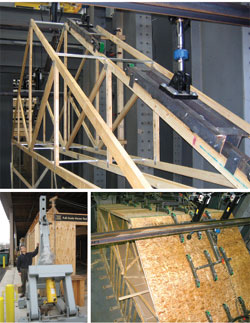Ongoing, On the Way
The other two facilities–one engaged in preliminary truss testing under the guidance of the University of British Columbia’s Department of Wood Science in Vancouver, and another enhancing the existing capabilities of the NAHB Research Center in Upper Marlboro, Md.–support the same concepts and goals as the SBCRI and APA research, as well as current technology and market practicalities.
“Because of the high cost and large number of possible structural forms [that could be tested], the idea is to combine the experimental work with computer modeling,” says UBC professor Frank Lam, enabling the actual testing to verify the computer models. “The verified model can then be used to predict the performance of other structural forms” without having to actually build and test them.
Like the SBCRI, Lam and his team will focus their initial testing on metal-connected parallel trusses, specifically lateral compression capacity and bracing requirements. A proprietary software, once verified by test results, will enable the scope to expand.
The NAHB Research Center, meanwhile, has conducted both industry supported and privately contracted structural testing for years, in many instances to help manufacturers get their systems through the ICC Evaluation Services process toward building code acceptance. “We work with manufacturers and the ICC-ES to modify the [code] acceptance criteria to accommodate new systems,” says Vladimir Kochkin, director of the research center’s applied engineering division.
To further that purpose, the research center opened a state-of-the-art facility in May 2007. “It’s the only of its kind in the country, designed to merge the market research capabilities required to identify technology gaps and the testing capabilities needed to develop and validate solutions based on objective performance,” says Kochkin. The goal, he says, is to reduce the time between the concept of a new structural technology and a fully commercialized, code-approved product or system.
The influx of new systems, he says, is driven in large part by the economics of OVE principles that, in turn, require an understanding of how and why built structures behave. “At a component level, there’s not a direct correlation to the behavior of a system under real-life loading conditions,” he says.
The other push is coming from the codes, specifically those along the coastlines that are concerned about a structural system’s ability to resist natural forces. But as codes change, Kochkin’s testing also provides builders and manufacturers with solid data as to what will comply.
“Where builders have to change their practices, and manufacturers have to accommodate the new codes and what builders need, our job is to develop design methods and practical construction solutions that allow system efficiencies be recognized,” he says. “Many times, our testing has an issue-driven agenda.”
–Rich Binsacca is a contributing editor to ProSales.



